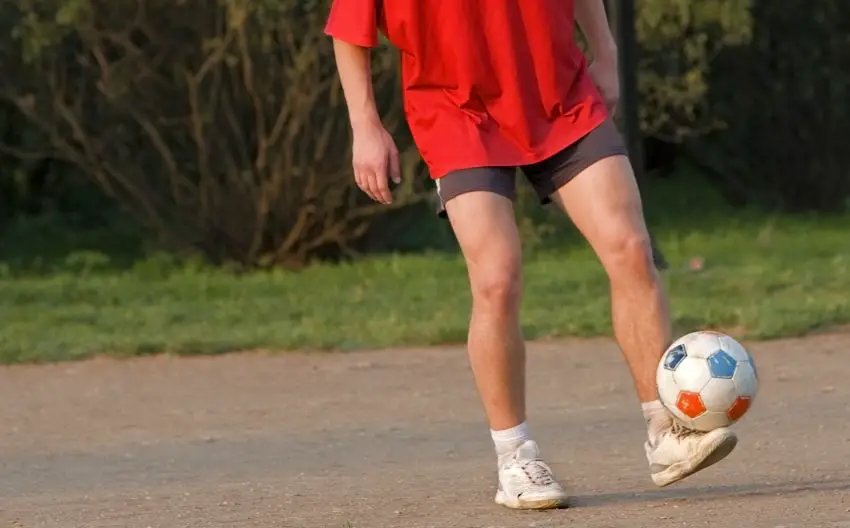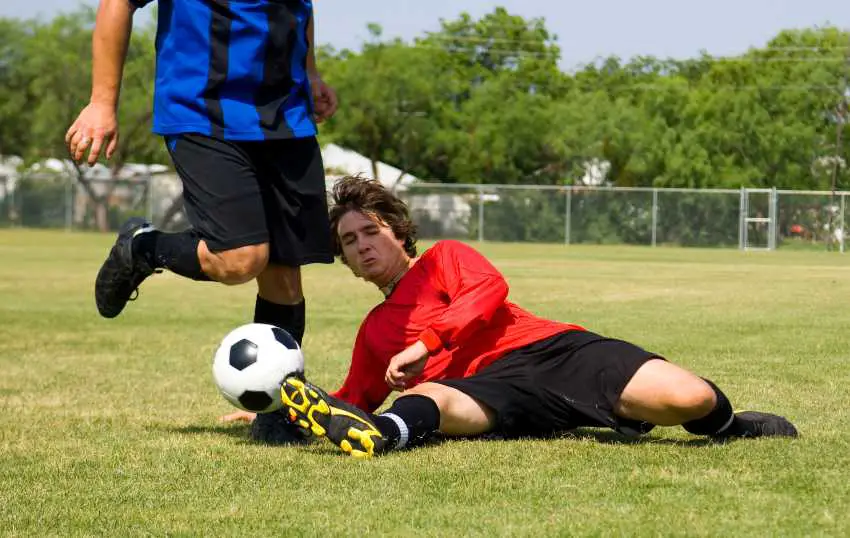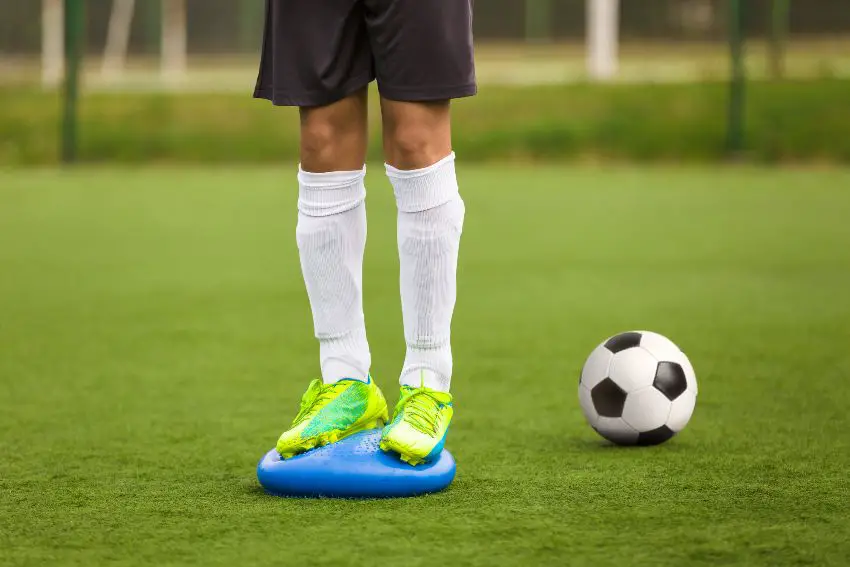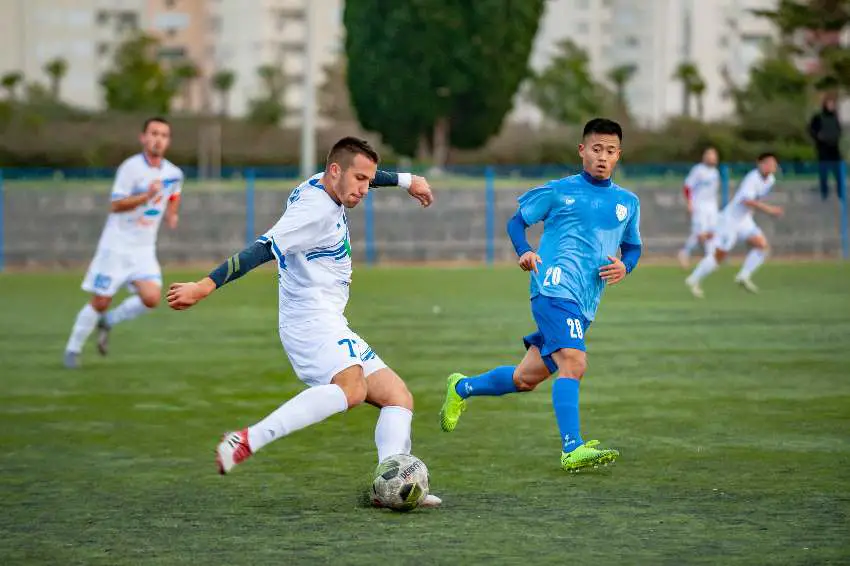
Playing soccer, especially at a competitive level, might present some challenges for you. One of the common ones is to choose the position you are going to play in!
Indeed, each position is different and requires a set of unique skills that you might or might not have.
That’s why you probably should not take such a choice for granted! Instead, you should do it carefully and right …
… In this article, I suggest to you 6 Steps to help you make an informed soccer position choice. By the end of this article, you should be able to have better idea of 1 or 2 positions that you might want to play in.
Step 1: Find out your top 3 to 5 skills …

This is an important step that most new players tend to skip!
Indeed, you have to assess your skills objectively and focus on their development.
The best way to do so is by trying different training drills. Performing these drills will give you a general picture of your current attributes.
You can do it on team training, or in your home yard!
Don’t be afraid to try some creative drills, and better yet to take video tapes of yourself performing them.
By seeing yourself performing those drills, you will instantly have a clear idea on what you are good at and what you are not that good at.
You can even ask someone more experienced to grade you over time and see if you are making progress and at which skills.
Bellow there are some drill idea suggestions that you can try:
Quick Tip: To be able to make the most out of these drills, I strongly recommend to always use soccer shoes or cleats with a decent quality to have the necessary comfort and grip to perform at the best of your abilities. You can have a quick look at these quality soccer cleats to get an idea!
1. Technical Drills
Ball control – try picking the ball of the ground at top speed, without slowing down
Passing – try to perform one touch passing
Dribbling – practice quick changing of direction
Heading – practice hitting the ball with your head precisely at teammate’s feet, at different distances
Shooting – try different shots at the goal, ground shots, volleys, long shots
2. Drills for Physical Attributes
Agility – perform flexibility exercises, twisting while running, fast getting up
Endurance – test your stamina level with running at different distances at high pace
Speed – run at short distance and with direction change
Strength – test yourself in duel game, 1 on 1 situations, and tackling challenges
3. Drills for Tactical awareness
Positioning – try following the direction of the ball and position yourself accordingly
Anticipation and Timing – practice different situations with teammate, when to run at the opponent or the ball
Composure – play a situation against several defenders and see how you react under pressure
4. Assess those Drills Properly …
If the player’s top skills are ball control, dribbling, agility and speed, his preferred positions should be winger and offensive midfielders.
If a player is the best in ball control, shooting and positioning, he has prerequisites for a striker.
Players with composure, positioning, anticipation, strength and heading are natural born center backs.
Players with great passing and ball control skill, in combination with positioning and anticipation, are good center midfielders.
Finally, if you think you are skilled enough, then you can check these soccer position suggestions for skilled players …
Step 2: Your Preferred Position Might Not Always Be the Right Choice …

After all, for most young kids, strikers are the role models. They are the ones that get the most attention and glory.
This naturally leads to many youngsters wishing to be forwards in their career and to prefer this position. However, this should not necessarily be the right choice for you.
Playing position should be the result of objective assessment of abilities and tendencies. Only with that kind of approach, you as a player can develop and improve your skills.
You should be aware that preferring specific soccer positions could confuse your mind. You must be aware of this, and leave picking the right position in accordance with objective assessment of your attributes.
If it happens that the position that you prefer the most is the one that matches your attributes then that’s Great! Otherwise, just stick to what you will be the best at.
You can learn about the hardest soccer positions out there and what it takes to be good at them …
Step 3: What workouts/drills you spend on time the most?

Training drills may be a decisive factor when it comes to picking playing position!
In fact, if you enjoy certain drills that are specific to some positions, you will definitely tend to learn the mentioned role.
In addition, you will look at that choice as a way to avoid drills you do not enjoy and find them tiring and even boring…
… For example, if you are the player that loves to have the ball at your feet, then you will enjoy the most ball control and dribbling drills. Picking these drills will essentially make you pick a position of offensive midfielder or winger. These are positions that are focused on developing technical abilities. You will also push yourself and do individual training with the focus on technical attributes.
Keep in mind that this is a dangerous ground. Indeed, picking the drills you love, and avoiding the ones you hate, will move you toward the position with a preferred training schedule. That can cost you a lot long term…
… The drills you enjoy are not necessary in line with the drills you need. And this should never influence the position you pick.
Lastly, if you are still a beginner, then you can check those beginner friendly soccer suggestions … I think you will find them useful!
Step 4: Understand Deeply What it Takes for Each Soccer Position!

This is probably the most important step!
Knowing the role and playing style of each position in soccer is a necessity for every player. Being familiar with each position makes the player more versatile and it is much easier to learn new roles on the field in the future.
Unlike in the past, modern soccer is a more dynamic and constantly changing sport. This demands players with a wider set of attributes and skills than ever before.
For example, although defender’s main responsibility is to mark opponents and prevent conceding goals, defenders today have an active role in building the attacking movement from the back line, covering midfield as a support, going into empty space up front (especially during free and corner kicks), etc.
Bellow, I go through every position and what it takes to be good at it in modern soccer:
Goalkeeper
Goalkeepers today are more included into tactics than in the past. We can say that goalkeepers, from seemingly passive roles, now acquire a more active role on the field. Some basic qualities goalkeeper must have:
- Reflexes. Goalkeeper’s main job is to prevent opponents from scoring. Having good reflexes is an essential skill to practice, especially for 1 on 1 situations.
- Agility. Keeper has to be agile and at top of physical preparation, so he can cover the goal area effectively.
- Anticipation. This attribute is essential for quality decision making. Goalkeepers are constantly put into situations where the difference between several alternatives are the difference between victory and defeat. Whether to rush toward the opponent or wait at the goal line, should he jump toward a high ball and grab it or punch it, or should pass the ball toward the player in the defensive line or kick it long. These are just some decision a goalkeeper must make. From his awareness and the ability to anticipate the outcome, depends on the success of an entire team.
- Communication. Goalkeeper’s task is to constantly communicate with the defensive line in order for defenders to achieve adequate positioning on the field. He is the one that must organize the entire back line.
- Passing. Yes, one of the skills necessary in modern games. Goalkeepers like Noyer and Ederson are some examples. These are the goalkeepers often described as “the third center back” in a team. They are the ones that start the attack, by passing the ball among defensive line, building up the attack from the back. In addition, they join the defensive line to help the defenders to deal with opponents’ pressure, by creating a surplus of players on their own half.
Keep in mind that goalie is in a general a good soccer position for taller players …
Defender – Central Backs
Center backs are the vital part of the defensive line. Their main task is to mark opposing strikers and keep their goal safe. Attributes that center back must possess are:
- Positioning. Defenders playing at this role have huge responsibility not to allow any gap in the defensive line and too much open space for opponents to exploit. They must follow the movement of both the ball and other players in order to position themselves accordingly.
- Determination. This is especially important when making sliding tackles or in a duel game. They must be decisive when rushing at the ball and keep calm under pressure.
- Endurance and strength. These are often the strongest players in the squad, as they are exposed to constant duel games with opponent’s strikers. In order to endure that kind of pace, they must be at an adequate level of physical preparation.
- Speed. This is important for both defending and attacking tasks. When defending, center backs must be capable of staying close to the player they are marking, not giving them a lot of space to act. In addition, speed is important when defending counter attacks, especially due to the fact that center backs now join the attack more often.
- Passing. This is necessary because of their active role in the opening phase of the attack from the back line.
- Heading. Defender must be able to clear the danger coming from corner kicks and long balls coming into their box. Also, defenders are the target men during offensive corner and free kicks.
Keep in mind that central backs is generally a soccer position that slower players that take …
Full Backs
Full backs play at defensive, on the left or right side. This is maybe the position that has evolved the most in soccer.
Once, full backs were delegated only the defensive tasks, without even going inside the opponents half of the court.
They were responsible solely for defending their team’s half. However, in modern soccer their role is quite different. The main characteristic of full backs today is the ability to run with and without the ball on the flanks and use the gaps and empty space up front.
The main skills full back should have are:
- Speed. This is the result of their newly invented role of offensive tasks. In addition, they are often responsible for covering opposing wingers, so they must be able to keep pace with them.
- Endurance and stamina. Full backs cover a significant distance on their side of the court. They actually have to run over the entire length of the field repeatedly during the match. This is an extremely physically demanding position, and without adequate level of stamina, it is not possible to endure the entire 90 minutes of the game.
- Long passing. Their main role during the attack is to exploit space on the flanks and help wingers. Therefore, they often have to send long, through balls, right into the opponent’s box.
- Dribbling. One of the main attributes of modern full backs is the ability to control the ball and dribble around the opponents. This is directly connected with their more offensive role and the goal to exploit the space on the side. Moreover, full backs often need to move the ball away from their half.
Keep in mind that full backs is good soccer position for faster players …
Center midfielder
Center midfielders play in the middle, and can have more offensive or defensive roles. Depending on this, we have a defensive midfielder, classic center midfielder, and attacking midfielder.
Attributes that center midfielders have to possess are:
- Passing. These players are often considered playmakers of their team. As the ones positioned in the center of the court, they are responsible for distributing the ball toward players at other positions and ensuring the flow of the ball around. So passing is essential for them.
- Decision making. Midfielders, especially playmakers, must all the time analyze the playing field and always know where their teammates and opponents are at every moment. This is the essential for making the right decision, as they are the ones responsible for keeping the possession of the ball.
- Ball control. Midfielders are under constant pressure from the opponents and must protect the ball. Having great ball control skill not only allows them to keep possession of it, but they are also able to react faster and send more passes that are precise.
Defensive midfielder
Defensive midfielders distinct themselves from other midfielders by their more defensive role. Their movement radius is wider, as they have to cover the area behind other midfielders, and in front of the defensive line.
They are not only responsible for supporting defense and preventing the attacks, defensive midfielders are also the connection between two lines of the team formation. That is why they must possess a high level of fitness and strength, to endure duels often.
In front of center midfielders we can often find an attacking midfielder. This is the position that either supports center midfielder, or it is the playmaker of the team. Maradona, Pele, Zidan, Messi, are all the players playing at this position.
In addition to skill needed for center midfielder, they must possess adequate speed and dribbling ability.
Wingers are the offensive midfielders that are positioned on one of the sides. Their skill set includes:
- Ball control and dribbling. Wingers are all the time under pressure from defenders and have many duels during the game. Their responsibility is to make use of limited space up front and create a chance for the strikers.
- Speed and acceleration. This is the mandatory for wingers. Their quickness, in combination with dribbling, is the crucial part of their role of exploiting the flanks and making effective crosses.
Forwards
And up front we have forwards. Their task is to make use of the chances and score goals. There are different types of forwards.
We have target men, like Ibrahimović, Kane, and Benzema, or ball masters like Mbappe, Agguero, and Neymar. Main skills striker must have are:
- Shooting. As they have to score goals, this is the first attribute they have to master. Their shooting ability will directly influence their success.
- Ball control is the necessity for them, because these players are often lone up front and have to hold the ball in their possession and protect it from defenders.
- Positioning. Other players try to pass the ball to them directly, or into empty space in front of them. The positioning will have impact on their finishing skill. They must be always on guard and position themselves in a way to be ready to react timely and make use of the gap in defense.
Step 5: Try all Soccer positions at a competitive level

Younger players can easily adapt to different roles and they can adapt their physical attributes and skills to play a position that is not their native one.
Youngsters are more open to experimenting and stepping out of their comfort zone. It is also an advantage in the beginning to change positions as much as possible. It will give you a better understanding of soccer and insight into teammate’s roles.
You never know which position is right for you until you try it out. Through playing at different positions at an early age, a player can more effectively realize the positions that he cannot or does not enjoy playing, and what are the positions that he loves.
In addition, after deciding the primary position, it is beneficial for young players to play in more than one position.
They will at least learn some tips and tricks of each position, which will be helpful in various situations during the game.
For example, a young player that learned to play defensive role, and the role of defensive midfielder, is definitely more useful and will be noticed by coaches than a player that is playing only defense.
Utility player is comfortable at finding himself in different situations and gives the option to coaches to change the tactics during the game, without making the substitution.
Step 6: Playing at more than one position is a good possibility

To play in different positions is an advantage and often a requirement for playing professional soccer today!
Coaches today tend to change formations and often change tactics, so being flexible and easily adjusting their team is something they are looking to accomplish.
If you are capable of playing in different positions equally good, this will be a great advantage. In addition to often changes of formation in order to adapt to tactical ideas, coaches have to think about challenges due to injuries and suspensions.
When we take into account the dynamics and pace of soccer today, we can say that the ability to play in multiple positions is one of the most valuable characteristics that a player can possess.
Sergio Ramos was in general a right back, the position he played as a Sevilla youngster. He continued to play at this position when he moved to Real Madrid. Due to the necessary squad and formation changes, Ramos started playing the position of center back at the age of 27.
Not only for Real Madrid, this was also the case with his role in Spanish national team. Not only that he adapted well, he is now considered one of the best center defenders in the world.
His technical abilities with and without the ball, as well as his athleticism level lead to him being in the role of a deep-lying defensive midfield role when needed.
Daniele De Rossi is one of Italian best midfielders of all time. Although natively a midfielder, during his career he has gradually migrated toward the defensive line.
Full backs that are physically impeccable and possess great speed that can be utilized up front, are useful at the position of winger, which is a more offensive role. Juan Cuadrado is an Italian Seria A star and a player that excels both at the positions of right back and right wing.
Quite used combination is the striker / offensive midfielder combo. Offensive midfielders move toward striker’s role in the need of changing to more attacking formation if needed.
Cristiano Ronaldo is a great example of this. His talent is fully utilized when he moves from one role to the other. He generally plays at a wider, offensive role. If needed, he can play as a center forward.
Agile and technically rich strikers often move to the offensive midfielder position. This was the case in Manchester United with players like Wayne Rooney and Robin Van Persie. This is happening often with time, when strikers mature and get necessary experience to play versatile roles.
Lionel Messi is considered a multi-positional master. He started his career as a winger, but under the guidance of Pep Guardiola he switched to the role of false 9. With time and with getting more experience and playmaking duties, he evolved to a role of number 10, but as the result of his technical attributes, more up front than classic number 10 players.
Keep in mind that generally (not always), captains should be able to play at multiple positions …
My Final Thoughts …
First of all, I hope this article was not too overwhelming for you since it is a little long! Other than that, I am happy that you’ve gone so far reading this article and probably others that talk about the same topic …
… This tells me that you are on the right path figuring out the appropriate position or even positions that you may want to opt for as a prospect soccer player.
If you fail at performing well at a specific position at the beginning, this doesn’t’ mean that this is the wrong one to choose, just persist in it long enough before making any kind of conclusion.
Hope that helps.
Finally, if you are looking for opportunities to become a football coach, then you definitely should have a look at these Good Offers. You will certainly find a proper position that will fit your current abilities
